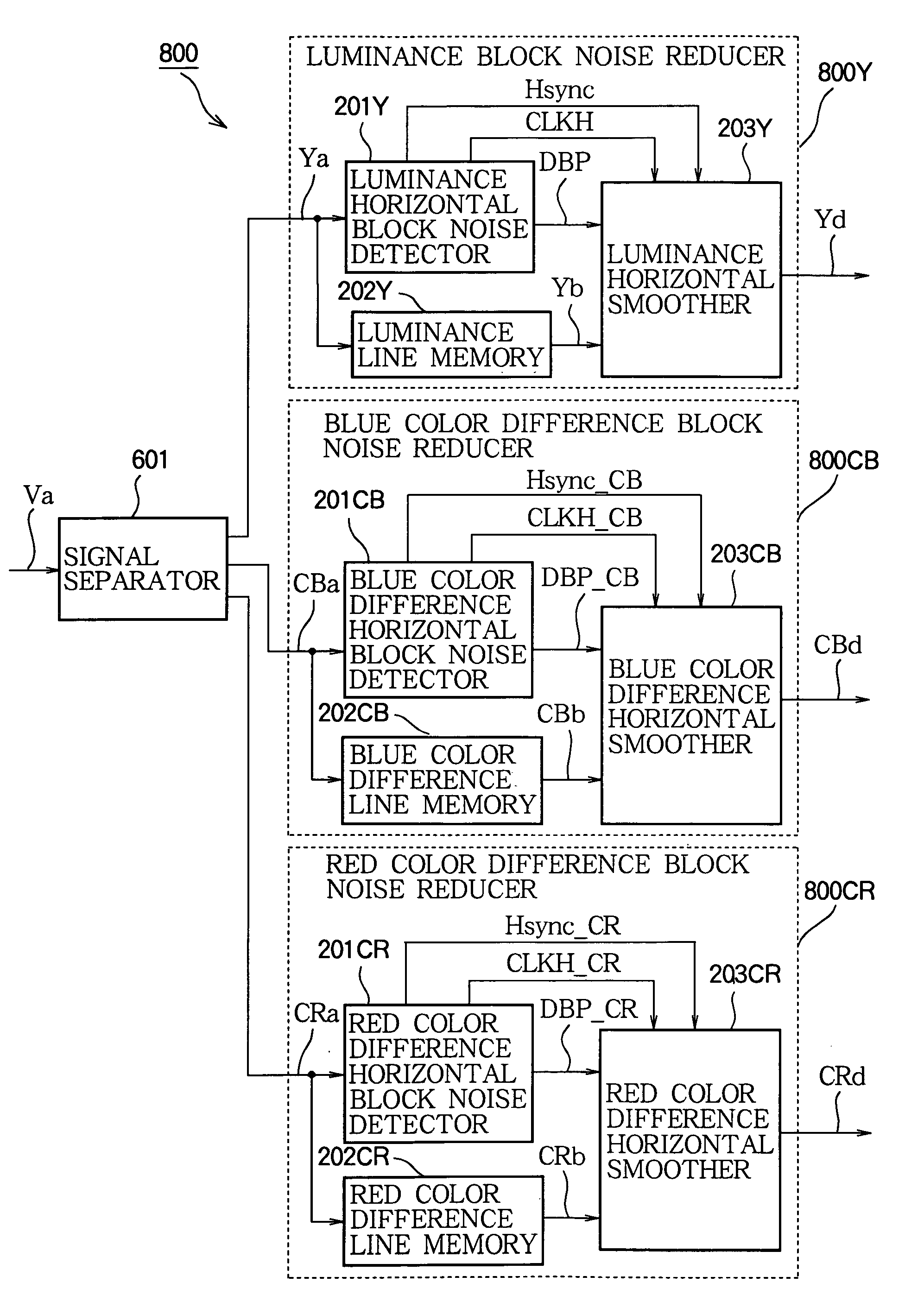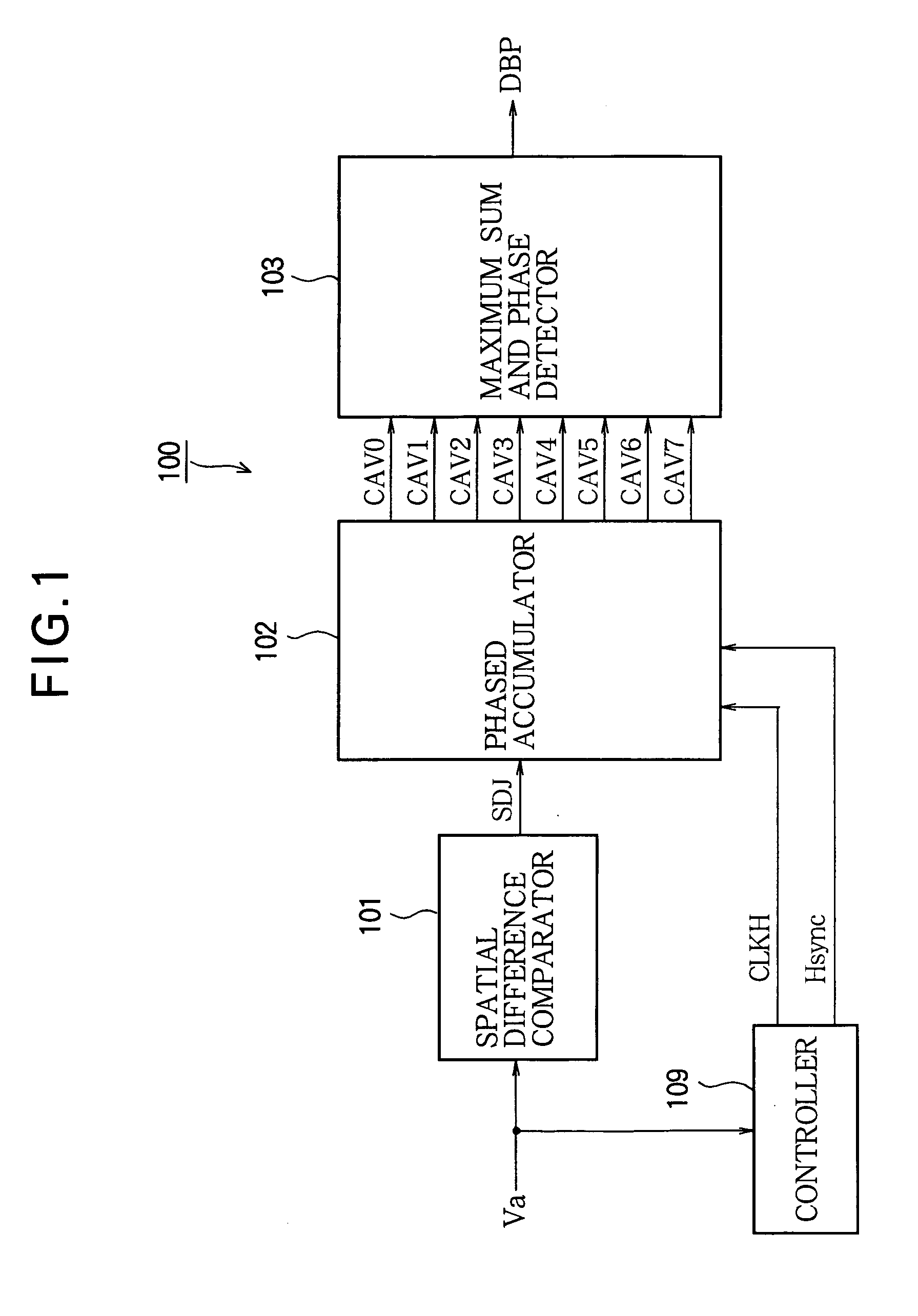Block noise detector and detection method, and block noise reducer and reduction method
a block noise detector and detection method technology, applied in the field of video signal processing, can solve the problems of significant luminance, block noise (also called block distortion), and failure to detect edges, so as to reduce the circuit size of the block noise detector, reduce the circuit size of the block noise reducer, and detect more accurately
- Summary
- Abstract
- Description
- Claims
- Application Information
AI Technical Summary
Benefits of technology
Problems solved by technology
Method used
Image
Examples
first embodiment
[0042]Referring to FIG. 1, the block noise detector 100 in the first embodiment comprises a spatial difference comparator 101, a phased accumulator 102, a maximum sum and phase detector 103, and a controller 109.
[0043]A monochrome input video signal Va is supplied to the spatial difference comparator 101 and the controller 109. The controller 109 extracts a horizontal synchronizing signal Hsync from the input video signal Va, generates a pixel clock signal CLKH with a period equal to the pixel sampling period, synchronized to the horizontal synchronizing signal Hysnc, and supplies CLKH and Hsync to the phased accumulator 102.
[0044]The controller 109 also extracts a vertical synchronizing signal Vsync, which is used together with the horizontal synchronizing signal to control the spatial difference comparator 101 and maximum sum and phase detector 103. A detailed description of the vertical synchronization operations will be omitted.
[0045]The spatial difference comparator 101 calcula...
second embodiment
[0084]Referring to FIG. 12, the block noise detector 300 in the second embodiment differs from the block noise detector 100 in FIG. 1 in the first embodiment by adding a phase consistency tester 104 on the output side of the maximum sum and phase detector 103. The maximum sum and phase detector 103 supplies the maximum phase signal MAP to the phase consistency tester 104.
[0085]The controller 109 in the block noise detector 300 in FIG. 12 extracts the horizontal synchronizing signal Hsync and vertical synchronizing signal Vsync from the input video signal Va, and supplies Hsync and Vsync to the phase consistency tester 104.
[0086]The phase consistency tester 104 stores the maximum phase signal MAP for eight consecutive lines, compares the eight stored values, and outputs the maximum phase signal MAP as the detected block phase signal DBP if the eight MAP values are identical.
[0087]An example of the internal structure of the phase consistency tester 104 is shown in FIG. 13. The phase c...
third embodiment
[0100]Referring to FIG. 16, the block noise detector 500 in the third embodiment differs from the block noise detector 100 in FIG. 1 in the first embodiment by adding a thresholder 105 on the output side of the maximum sum and phase detector 103. The maximum sum and phase detector 103 supplies the maximum value signal MAS and the maximum phase signal MAP to the thresholder 105.
[0101]The thresholder 105 compares the input maximum value signal MAS with a threshold value and outputs the maximum phase signal MAP as the detected block phase signal DBP, but outputs the detected block phase signal DBP only when the maximum value signal MAS is greater than the threshold value.
[0102]Because the block noise detector 500 outputs the detected block phase signal DBP only when the maximum value signal MAS is greater than the threshold value, as described above, the block noise detector 500 does not mistakenly detect a rectangle forming part of the image in a video field as block noise.
[0103]A blo...
PUM
 Login to View More
Login to View More Abstract
Description
Claims
Application Information
 Login to View More
Login to View More - R&D
- Intellectual Property
- Life Sciences
- Materials
- Tech Scout
- Unparalleled Data Quality
- Higher Quality Content
- 60% Fewer Hallucinations
Browse by: Latest US Patents, China's latest patents, Technical Efficacy Thesaurus, Application Domain, Technology Topic, Popular Technical Reports.
© 2025 PatSnap. All rights reserved.Legal|Privacy policy|Modern Slavery Act Transparency Statement|Sitemap|About US| Contact US: help@patsnap.com



